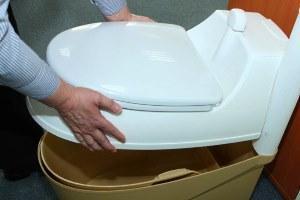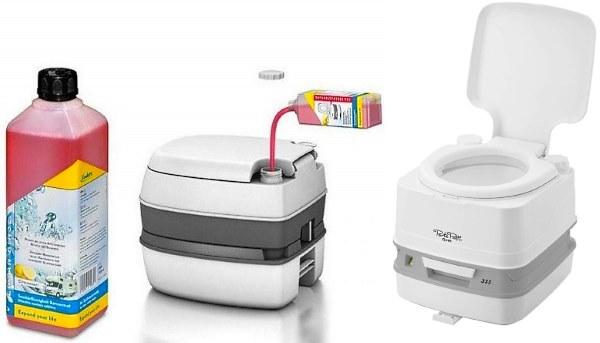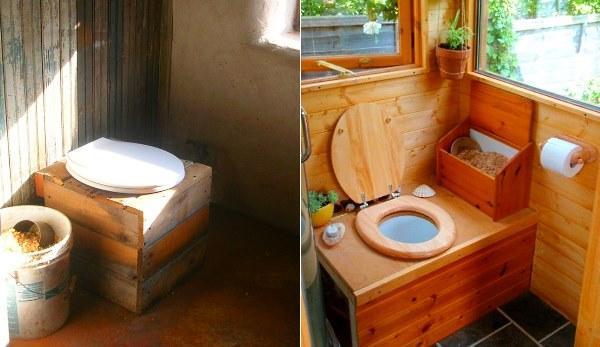A dry closet for a summer residence is a simple solution to a difficult task
 Without toilet a house outside the city is indispensable. But if there was no alternative to the standard "birdhouse" hidden from prying eyes somewhere in the corner of the plot, today there is another interesting option, and not even one - these are dry closets for giving different designs.
Without toilet a house outside the city is indispensable. But if there was no alternative to the standard "birdhouse" hidden from prying eyes somewhere in the corner of the plot, today there is another interesting option, and not even one - these are dry closets for giving different designs.
A modern dry closet is a compact device that does not require time-consuming and expensive laying of communications and is installed both in a separate building on the site and inside a residential building. Such dry closets for summer cottages are distinguished by enviable simplicity in installation and further operation.
Classification of dry closets
Depending on the capacity and dimensions, dry closets can be easily divided into two large classes:
- portable structures that are easily installed in any convenient place, including inside a residential building;
- stationary structures, often mounted in a separate room.
The principle of the dry closet
According to the principle of operation of different models, the following groups can be distinguished:
- Chemical toilets operating on various sanitary fluids;
- Peattoilets producing biocompost;
- Electric models.
Chemical portable toilets for summer cottages
Chemical dry closets are modern compact devices, which must include an upper part, including a seat and a flush pump for waste disposal, and a hermetically sealed storage tank. The principle of operation of this type of dry closet is based on the splitting of feces by means of a specialized reagent added to the tank. All waste entering the toilet is flushed with water into a receiving container, where a decomposing compound is added, which prevents gas formation, accompanied by the spread of an unpleasant odor, and converts the waste through a chemical reaction.
Such a mobile dry closet for a summer residence is very convenient, but whether it is possible to apply the "bio" prefix to the device depends on the chemical composition used by its owners.
Chemical preparations for dry closet
They are available in three types:
- Formaldehyde reagents, which cannot be attributed to safe compounds, therefore, it is better to dispose of recycled waste from a dry closet for a summer residence away from housing and plantings.
- Liquid ammonium reagents become safe after 3 to 7 days after being added to the tank.
- Preparations in which live bacteria are introduced are completely harmless, and the waste processed with their help is a good fertilizer for the site.
If we compare dry closets with a chemical principle of operation, then designs using sanitary liquids of the third type are preferable.
And here not only the safety of the device is important, but also its compactness. What is important when living in a country house for small children or older relatives, since portable toilets of this type can be conveniently located in the house.

The downside of the design can be considered the need to constantly replenish the toilet with a not too cheap reagent. And for the recycling to be complete, you will also need special soluble toilet paper.
Peat dry closet
Because of their ease of maintenance and environmental friendliness, these toilets outperform toilets with a cesspool.And for the device of the simplest peat bio-toilet, the summer resident will need: a toilet seat with a bucket, a container for filler, dry peat and an equipped place for collecting compost.
A peat dry closet for a summer residence has a lower container for collecting human waste products. To use a country toilet on peat, no water is required at all, since feces enter the peat, which must be poured into the toilet immediately before use and immediately after it.

Unlike a toilet using chemical reagents, a peat dry closet for a summer residence is intended for installation outside the house. If the structure is nevertheless placed next to living quarters, then a ventilation system must be installed in the toilet room, since peat cannot completely remove the smell of peat.
Separation of waste into liquid and solid fractions can be provided in a peat dacha dry closet. The urine collected in a separate container is regularly drained through a drainage hose into the ground, and the feces mixed with peat are collected in a tank, from where, as the container is filled, they are taken out into the compost pit.

The peat dry closet has many advantages:
- First, no water is needed to use such a device;
- The period between tank cleaning is longer than when using a chemical toilet;
- Neither waste nor products of their processing pollute the environment;
- The relative cheapness of a peat dry closet;
- Low price for peat filler.
From users of peat dry closets for giving reviews, only positive reviews are always received, but there are also disadvantages here:
- Ventilation is required, which complicates and slows down the installation;
- It is important to consider draining urine and equip drainage;
- Stationary structure;
- Large, in comparison with dry closets on chemical reagents, dimensions.
The choice of filler for peat dry closet
The bacteria contained in peat contribute to the speedy decomposition of human biological waste and their transformation into fertilizer for the summer cottage. When sprinkling with peat, firstly, the spread of an unpleasant odor is suppressed, and secondly, the fastest composting of feces is ensured.
Peat filler for dry closets is required only. At the same time, it is convenient and safe to store it next to the toilet seat and fill it up every time before and after using the toilet.
Sometimes it is advisable to use sawdust or small shavings in these composting toilets. However, such a replacement will not give the desired effect and will not speed up the processing of waste into compost. And if sawdust is used, then it is better to make a mixture of equal parts of peat and wood filler and only if the toilet receiving tank with a capacity of at least 50 liters. Then the substrate will be provided with adequate aeration.
Continuous composting dry closet
Such a toilet is distinguished by its complexity, justified by the continuity of its operation. Therefore, all the time and money spent on arranging this type of toilets will quickly pay off with ease of use. There is no need to deal with dirty waste here, and a complete compost is obtained during the processing. With sufficient ventilation in such a toilet there is not a hint of an unpleasant smell, and the entire mechanism functions without water supply.

The heart of the continuous composting toilet is the volumetric incline chamber where the compost is formed. The bottom slope should be 30 degrees. To make the processing process more intensive, and the waste has the necessary loose structure, peat is regularly added through the loading door into the chamber.
 Diagram of a peat toilet with urine collection. It should be noted that, by analogy with conventional dry closets, sawdust or peat is added through the bowel hole.
Diagram of a peat toilet with urine collection. It should be noted that, by analogy with conventional dry closets, sawdust or peat is added through the bowel hole.
- A. Second floor
- First floor
- Ground floor
- Humus compartment
- Ventilation tube
- Bathroom
- Urinal
- Urine collection and dehydration.
Electric toilets
The principle of operation of a dry closet on electricity, more similar to a toilet, is based on initial drying, and then on burning with a solid fraction of waste. The liquid component is collected separately and discharged through a hose into the ground or into the external sewerage.
The conducted review of dry closets for summer cottages allowed us to conclude that toilets using electricity are justified only where, in addition to electrical wiring, there is a possibility of arranging drainage and a high-quality ventilation system. This significantly increases the cost of the project, therefore, for seasonal dachas, such devices are unprofitable.
Selection rules
When choosing a portable toilet for a summer residence, it is important to consider the following points:
- Waste storage tank capacity. The frequency of emptying depends on this indicator. On average, a tank with a capacity of up to 14 liters is enough for 30 uses, so it is important to try to calculate the required capacity so that all family members are comfortable using the toilet and cleaning it is not burdensome.
- The weight of the filled storage tank. Striving for convenience, many people choose unnecessarily large tanks, which then makes it difficult to remove and clean them. The weight of a full 14-liter tank is approximately 15 kg, and here it is important to assess your own strength and capabilities for waste disposal.
- The height of the dry closet. How to choose a dry closet for a summer residence if the family has children? First of all, take into account the height of the seat, and, of course, the safety of using the structure.
Dry closet in winter
Today more and more country houses are not empty even in winter. If the toilet is located in a heated room, then there is nothing to worry about. The situation is different when the amenities are outside.

For comfortable living, a free-standing toilet must function reliably even in sub-zero temperatures. When comparing dry closets, it turns out that it is better to opt for a design that runs on peat or on a chemical reagent. Today, there are non-freezing liquids for chemical toilets, while peat, while keeping it dry, does not freeze even in frost. Either one or the second solution does not require additional costs.
The second important factor is the use of only frost-resistant materials in the toilet, especially plastic.
Modern dry closets are more likely a necessity than a luxury item. In order to provide comfortable conditions for staying in the country, in the absence of an opportunity to install centralized water supply and sewerage systems into the house, a dry closet is the most optimal solution. For a long time I was looking for a way to bring all the necessary amenities into the house, but it didn’t work, and then it was not at all before. I solved this problem easier - I bought a dry closet.
And which dry closet did you take?